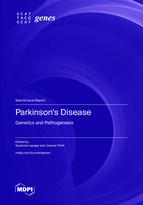Parkinson's Disease: Genetics and Pathogenesis
A special issue of Genes (ISSN 2073-4425). This special issue belongs to the section "Human Genomics and Genetic Diseases".
Deadline for manuscript submissions: closed (15 July 2022) | Viewed by 41517
Special Issue Editors
Interests: genetics of Parkinson’s disease and other neurodegenerative disorders; next-generation sequencing; exomes; whole genomes; transcriptomics; genome-wide association studies
Special Issue Information
Dear Colleagues,
Parkinson's disease (PD) is a common and incurable neurodegenerative disease, affecting 1% of the population over the age of 65. Although the disease remains defined clinically by its cardinal motor manifestations and pathologically by midbrain dopaminergic cell loss in association with intraneuronal Lewy bodies, the molecular mechanisms that lead to neurodegeneration remain elusive. It is becoming increasingly clear that genetic factors contribute to its complex pathogenesis. The last 25 years have seen great progress towards understanding the genetic basis of this disease, with the identification of disease-causing genes. At least 23 loci and 13 genes clearly linked to inherited forms of Parkinsonism have been identified to date; genome-wide association studies have provided convincing evidence that polymorphic variants in these genes contribute to sporadic PD. The knowledge acquired of the functions of their protein products has revealed pathways of neurodegeneration that may be shared between inherited and sporadic PD. Impressive sets of data in different model systems strongly suggest that mitochondrial dysfunction plays a central role in clinically similar, early-onset autosomal recessive PD forms caused by parkin and PINK1, and possibly DJ-1 gene mutations. By contrast, alpha-synuclein accumulation in Lewy bodies defines a spectrum of disorders ranging from typical late-onset PD to PD dementia and including sporadic and autosomal dominant PD forms due to mutations in SCNA and LRRK2. However, the pathological role of Lewy bodies remains uncertain, as they may or may not be present in PD forms with one and the same LRRK2 mutation. The impairment of autophagy-based protein/organelle degradation pathways is emerging as a possible unifying pathogenic scenario in PD. Strengthening these discoveries and finding other convergence points by identifying new genes responsible for Mendelian forms of PD and exploring their functions and relationships is the main challenge for the next decade. In this issue, emerging lessons on PD pathogenesis from clinical, pathological, and genetic studies towards a unified concept of the disorder will be provided, which may accelerate the design and testing of the next generation of PD therapies.
Dr. Suzanne Lesage
Dr. Joanne Trinh
Guest Editors
Manuscript Submission Information
Manuscripts should be submitted online at www.mdpi.com by registering and logging in to this website. Once you are registered, click here to go to the submission form. Manuscripts can be submitted until the deadline. All submissions that pass pre-check are peer-reviewed. Accepted papers will be published continuously in the journal (as soon as accepted) and will be listed together on the special issue website. Research articles, review articles as well as short communications are invited. For planned papers, a title and short abstract (about 100 words) can be sent to the Editorial Office for announcement on this website.
Submitted manuscripts should not have been published previously, nor be under consideration for publication elsewhere (except conference proceedings papers). All manuscripts are thoroughly refereed through a single-blind peer-review process. A guide for authors and other relevant information for submission of manuscripts is available on the Instructions for Authors page. Genes is an international peer-reviewed open access monthly journal published by MDPI.
Please visit the Instructions for Authors page before submitting a manuscript. The Article Processing Charge (APC) for publication in this open access journal is 2600 CHF (Swiss Francs). Submitted papers should be well formatted and use good English. Authors may use MDPI's English editing service prior to publication or during author revisions.
Keywords
- Parkinson’s disease
- Genetics
- Molecular pathogenesis
- Pathways
- Physiopathological mechanisms
- Mitochondrial dysfunction
- Parkin
- PINK1
- SNCA
- LRRK2
- Animal model
- Cell model








